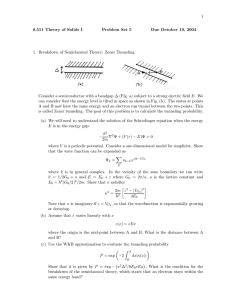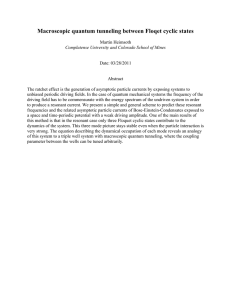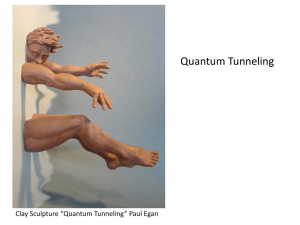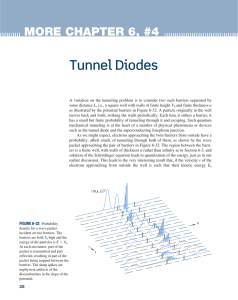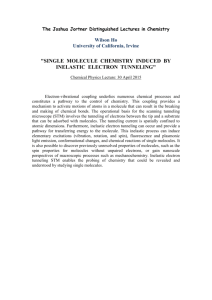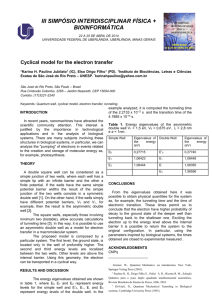Quantum Transport Devices Based on Resonant Tunneling
advertisement
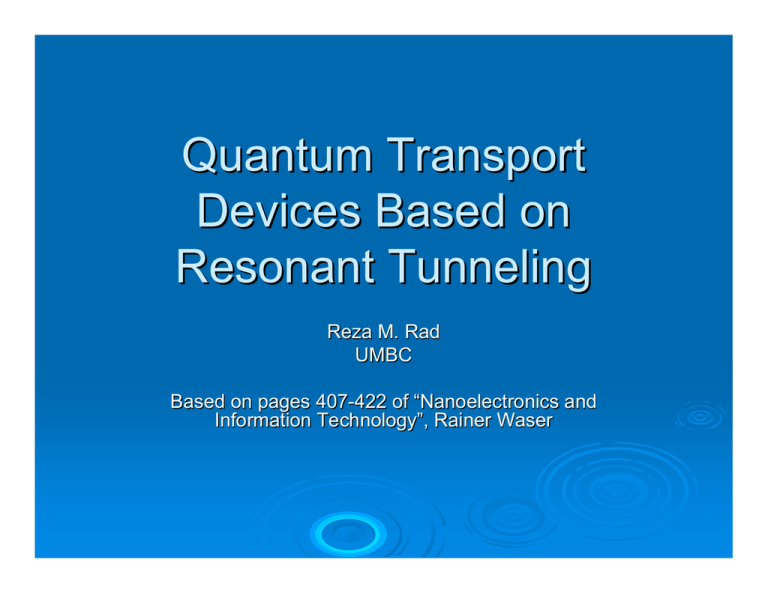
Quantum Transport Devices Based on Resonant Tunneling Reza M. Rad UMBC Based on pages 407-422 of “Nanoelectronics and Information Technology”, Rainer Waser Introduction ¾ Some general aspects of resonant tunneling diodes will be discussed ¾ RTDs can be considered as devices which are in active competition with conventional CMOS Electron Tunneling ¾ Transfer Matrix Method z z z z z Electrons have a wave like character In structures with dimensions in the range of electron wavelength, quantum mechanical transport becomes relevant One of these transport mechanisms is the tunneling process Electrons can penetrate through and traverse a potential barrier with a finite transmission probability independent of temperature In classical view electrons can overcome a potential barrier only thermodynamically Electron Tunneling z z Envelope function description of electron state : rapid changing electron potential is approximated with an envelope potential Envelope function is based on effective mass description of the band structure and leads to electron effective mass Schrödinger equation : ⎡ h2 d 1 ⎤ d + Φ ( z ) ⎥ Ψ ( z ) = Wz Ψ ( z ) ⎢− * ⎢⎣ 2 dz m ( z ) d ( z ) ⎥⎦ Ψ ( z ) : electron wave function, Wz : electron energy is Z direction m* : electron effective mass , Φ (z) : potential energy at the conduction band minimum Electron Tunneling z z Occupation probabilities can be predicted from absolute 2 | Ψ ( z ) | square of wave function Consider a sequence of n different layers (fig 1) with different potential energies (φi) and electron effective masses (m*i) Electron Tunneling z Ψi(z) can be written as a superposition of propagating waves in z and –z direction with amplitudes Ai and Bi Ψi ( z ) = Ai eiki z + Bi e − iki z := Ai Ψi + + Bi Ψi − boundary conditions : Ψi ( zi ) = Ψi +1 ( zi ) 1 d 1 d z Ψ = Ψi +1 ( zi ) ( ) i i * * mi dz mi +1 dz In matrix form : Ψi − ⎤ ⎡ Ψi + 1 ' ⎥ definition : TM i := ⎢ 1 ' Ψ i− ⎥ ⎢ Ψ i+ mi ⎣ mi ⎦ ⎡ A3 ⎤ ⎡ A1 ⎤ ⎡ A2 ⎤ ⎡ A2 ⎤ TM1(z = z1) ⎢ ⎥ = TM 2(z = z1) ⎢ ⎥, TM 2(z = z2) ⎢ ⎥ = TM 3(z = z2) ⎢ ⎥,... ⎣ B1 ⎦ ⎣ B2 ⎦ ⎣ B2 ⎦ ⎣ B3 ⎦ ⎡ An −1 ⎤ ⎡ An ⎤ TM n -1(z = z n-1 ) ⎢ ⎥ = TM n(z = z n-1 ) ⎢ B ⎥, B ⎣ n −1 ⎦ ⎣ n⎦ Electron Tunneling z Amplitudes of the propagating waves in z and –z direction in last layer can be written as: ⎡ An ⎤ ⎡ A1 ⎤ ⎢ B ⎥ = TM ⎢ B ⎥ ⎣ 1⎦ ⎣ n⎦ TM = TM n−(1z = zn−1 ) ...TM 2 ( z = z 2 )TM 2−(1z = z 2 )TM 1( z = z1) z Transmission probability Tc can be written as the ratio of outgoing to the incoming quantum mechanical probability current: k n m1* | An |2 det TM Tc = * n k1 m | A1 | det TM = 2 , An = k1 m n k n m1 k1 m n* 1 Tc = k n m1* | TM 22 |2 TM 22 A1 Electron Tunneling ¾ Tunneling through a single barrier z A single potential barrier is shown in figure (fig2) • AlAs barrier embedded in GaAs Electron Tunneling z z z Transmission probability is calculated as a function of electron energy Finite transmission probability for electrons below potential height of 1 eV (tunneling) The smaller the barrier thickness the higher the tunneling probability Electron Tunneling ¾ Tunneling through a double barrier structure z Figure (fig 3) shows the case of tunneling through a double barrier structure • 4 nm tick AlAs barriers separated by a 5 nm GaAs well Electron Tunneling z In contrast to single barrier, there are three sharp maxima below 1 eV • Interpreted as quasi-bound states with narrow energetic bandwidth through which electrons can tunnel through open channels in the barrier z z This is not describable by a sequential picture of two wells Quantum mechanical devices cannot be put too close together without changing the characteristics of the single device Resonant Tunneling Diodes ¾ Resonance properties z z z Resonant tunneling diode is the experimental realization of double barrier structure Figure (fig 5) shows the behavior of resonances A resonance can be considered as a channel which opens electron flux, current density first increases then decreases Resonant Tunneling Diodes ¾ Current voltage characteristics z z z Current density can be calculated based on transmission probability and the corresponding occupation densities Text gives a relation for calculating current density based on the potential profile φ of the structure The potential can be obtained by coupling effective mass Schrödinger equation with Poisson equation in a self-consistent manner Resonant Tunneling Diodes z z z Figure (fig 6) shows a typical currentvoltage characteristic Negative differential resistance is a main feature The quantum device simulation package NEMO (NanoElectronic MOdeling) simulates a wide variety of quantum devices including RTDs Resonant Tunneling Diodes ¾ Interface and growth temperature z z z PVR (Peak to Valley Ratio) is a merit of quality for RTDs Highest PVR coincides with sharpest interface between barriers and the well Temperature range between 580 and 600 results in highest PVR for AlAs/GaAs RTDs (fig 8) Resonant Tunneling Devices ¾ Operation Speed of RTDs z z z z One of the most attractive features of RTDs is their potential for extremely high speed operation RTDs with 712 GHz oscillation and 1.5 ps switching times have been reported It is important to differentiate “tunneling time” and “RC time” Tunneling time is in order of the resonant-state lifetime or escape time which is the time it takes an electron in the quantum well to escape from it: Resonant Tunneling Devices z z z Shorter tunneling times can be obtained with thinner and lower barries Various non-idealities affect tunneling time in real RTDs Tunneling time determines the intrinsic delay of RTDs Resonant Tunneling Devices z z z In most applications, operation speed of RTDs is limited not by the intrinsic tunneling time but by the charging time of RTD capacitance Equivalent circuit of RTDs is shown in figure (fig 10) The capacitance-voltage curve is also shown in the figure Resonant Tunneling Devices ¾ Applications of RTDs z z Several applications exploit negative differantial resistance (NDR) of RTDs Resonant tunneling transistors • To make a three terminal tunneling device RTDs are merged with conventional transistors and resonant tunneling bipolar transistors, resonant tunneling hot electron transistors and gated RTDs are fabricated Resonant Tunneling Devices • Gated RTDs have Schottkey or junction gates around the emitter to control RTD area z Concept of Monostable-Bistable transition logic elements (MOBILES) • The ultrahigh-speed logic gate : MOBILE exploits NDR of the RTDs • A circuit consisting of two NDR devices connected serially, to exploit monostable to bistable transition • Bias voltage is oscillated to generate the transition • NDR devices with third terminal are used to modulate their peak currents Resonant Tunneling Devices • Figure (fig 12) shows the load curves and the corresponding potential energy diagrams • Figure (fig 13) shows the operation of a simple MOBILE inverter Resonant Tunneling Devices ¾ Integration Technology for MOBILEs z z z NDR devices with third terminal are required for MOBILEs Gated RTDs were first used as three terminal NDR device, however they have disadvantages including high capacitance, difficult to optimize the layer structure, low PVR and difficult to fabricate To overcome the problems, RTDs connected in parallel with HEMTs were fabricated Resonant Tunneling Devices ¾ Examples of MOBILEs z Figure (fig 17 , 18) shows implementation of a weighted sum threshold logic function Resonant Tunneling Devices • Figure (19, 20 ,21) demonstrate a test circuit for evaluating operation speed of the MOBILE and the estimated power consumption Resonant Tunneling Devices z z One of the promising applications of MOBILEs is analog-to-digital-converter (ADC) Figure (fig 22) shows a block diagram of a ∆Σ ADC Resonant Tunneling Devices z z z z ∆Σ modulator converts analog input into a pulse density at a frequency much higher than the Nyquist rate The filter cuts the high frequency component and down converts pulse density into the high-resolution digital output at Nyquist rate Higher resolution can be obtained by increasing sampling rate This method does not require a high accuracy analog component Resonant Tunneling Devices z z z MOBILEs can be used to fabricate high performance ∆Σ modulator Adder and shifter circuits used in digital filter can also be fabricated by MOBILEs Figure (fig 23) shows a ∆Σ modulator based on MOBILE
